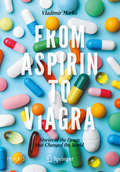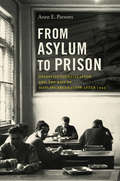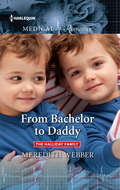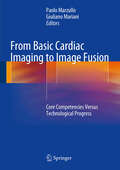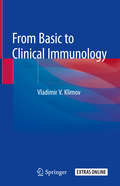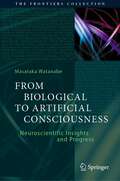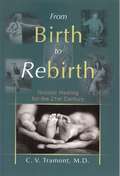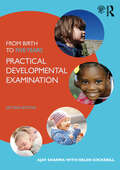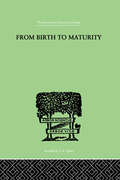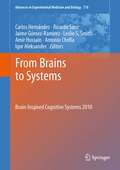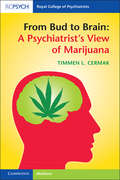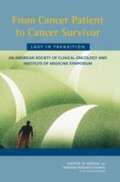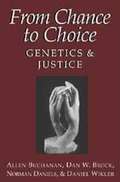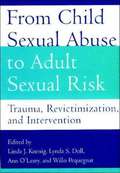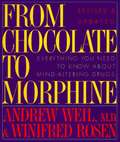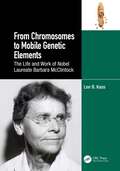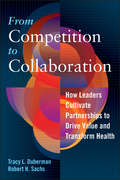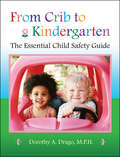- Table View
- List View
From Aspirin to Viagra: Stories of the Drugs that Changed the World (Springer Praxis Books)
by Vladimir MarkoFrom Aspirin to Viagra, insulin to penicillin, and vaccines to vitamin supplements, drugs have become part of our everyday lives. This staggering global industry wasn’t born overnight; advancements in pharmaceutical science have been happening for a long while, over the course of decades and even centuries.This book tells the history of ten prominent substances and how they came to be common household names. It shows how the creation of such influential drugs often began with the right person at the exactly right—or wrong!— time. The chapters tell the stories of geniuses and charlatans; scholars and amateurs; advances won through hard work or pure luck; and ultimately, the handful of resounding successes that revolutionized a global industry.Beyond the pioneers of the most famous drugs in our culture, the book analyzes how our perspective on medical treatment has shifted over the decades. Modern standards for testing and administering substances have created a new set of advantages, setbacks, and stigmas, all of which are discussed herein.
From Asylum to Prison: Deinstitutionalization and the Rise of Mass Incarceration after 1945 (Justice, Power, and Politics)
by Anne E. ParsonsTo many, asylums are a relic of a bygone era. State governments took steps between 1950 and 1990 to minimize the involuntary confinement of people in psychiatric hospitals, and many mental health facilities closed down. Yet, as Anne Parsons reveals, the asylum did not die during deinstitutionalization. Instead, it returned in the modern prison industrial complex as the government shifted to a more punitive, institutional approach to social deviance. Focusing on Pennsylvania, the state that ran one of the largest mental health systems in the country, Parsons tracks how the lack of community-based services, a fear-based politics around mental illness, and the economics of institutions meant that closing mental hospitals fed a cycle of incarceration that became an epidemic.This groundbreaking book recasts the political narrative of the late twentieth century, as Parsons charts how the politics of mass incarceration shaped the deinstitutionalization of psychiatric hospitals and mental health policy making. In doing so, she offers critical insight into how the prison took the place of the asylum in crucial ways, shaping the rise of the prison industrial complex.
From Bachelor to Daddy
by Meredith WebberCan he let go of the past……and commit to the future——as a dad?Paramedic Marty Graham doesn’t do commitment—he knows all too well how damaging family life can be. But single mom Dr. Emma Crawford is different, and she’s looking for a dad for her adorable twin boys… Will one night of sizzling passion change everything for Marty and Emma?
From Basic Cardiac Imaging to Image Fusion
by Giuliano Mariani Paolo MarzulloThe recent development of three-dimensional imaging techniques has provided an enormous amount of information relevant to the clinical management of patients at low and high risk for coronary artery disease. However, while progress in each individual technique has been rapid, the correlation of findings obtained with radiology, nuclear medicine, and magnetic resonance imaging is still relatively neglected. In this book, qualified experts in cardiac imaging present the basic concepts of cardiac pathology and imaging and compare the findings obtained in particular subspecialties with those acquired using other techniques. In this way the reader will learn how images and techniques can be integrated in clinical practice to the benefit of the patient. In addition, it is explained how appropriate multimodality integration can reduce the patient's exposure to ionizing radiation. Physicians ranging from cardiac surgeons to internal medicine specialists and even public health administrators will find this book invaluable in understanding the role of hybrid cardiac imaging.
From Basic to Clinical Immunology
by Vladimir V. KlimovThis book fills a gap at the interface of fundamental and clinical immunology, and allergy. For many years, experts in fundamental immunology and physicians involved in clinical immunology and allergy worked separately – but the fundamental immunologists did not have medical qualifications and the physicians were not involved in the field of fundamental research. Written by a teacher and an expert in both fields, this book combines current knowledge on basic immunology and immunopathology with clinical comments that complete the whole picture.Immunology is a complex science, which requires a simplified approach in order to be taught and understood effectively. This book is based on the authors’ long experience in teaching undergraduate, postgraduate students and interns both basic and clinical immunology.Reviewing a variety of important components related to the immune system, it is clearly and logically structured, and enriched by figures, tables and boxes with important immunology definitions. Each chapter has its own bibliography, and most units include links to electronic quizzes and audio files to accompany readers step by step. This easy-to-follow volume concludes with suggestions for future study. It is a valuable resource for undergraduate and postgraduate students, as well as medical practitioners.
From Biological to Artificial Consciousness: Neuroscientific Insights and Progress (The Frontiers Collection)
by Masataka WatanabeHow does consciousness emerge from a brain that consists only of physical matter and electrical / chemical reactions? The deep mysteries of consciousness have plagued philosophers and scientists for thousands of years. This book approaches the problem through scientific studies that shed light on the neural mechanism of consciousness, and furthermore, delves into the possibility of artificial consciousness, a phenomenon that may ultimately solve the mystery. Finally, two key suggestions made in the book, namely, a method to test machine consciousness and a theory hypothesizing that consciousness emerges from a neural algorithm, reveal a novel and credible pathway to mind-uploading.The original Japanese version of this book has become a best-seller in popular neuroscience and has even led to a neurotech startup for mind-uploading.
From Birth To Rebirth: Gnostic Healing For The 21st Century
by Charles V. TramontFrom Birth to Rebirth is the heart-warming true story of a dedicated obstetrician whose interest in hypnosis develops into a passion for using past-life regression as an exciting healing modality. After making his way through the rigors of medical training and the trenches of daily practice, Dr. Tramont now finds himself evolving into a pragmatic Gnostic. For thousands of years, Gnostics have believed that liberation comes from knowledge of who you are, why you are here, and where you came from. Far from being an ancient, obscure, and little-understood theology, Gnosticism is emerging today as newly valid, mainstream, and clearly relevant. In From Birth to Rebirth you will find yourself sharing Dr. Tramont's excitement as his curiosity regarding past lives escalates into full-blown research that takes him down the extraordinary pathway of spiritual enlightenment. His growing interest in therapeutic hypnosis guides him through the complex domain of the mind as he begins to discover other dimensions and the significance of previous lives to present health. To Dr. Tramont's amazement, guiding individuals through therapeutic regressions of their previous lives enables them to successfully heal themselves of many emotional and physical problems. His discovery of the extreme effectiveness of this rather miraculous method of healing has profoundly affected the way he views medicine, and, for that matter, even the nature of reality itself. In From Birth to Rebirth you will accompany Dr. Tramont on a wild ride as he encounters surprises at every turn and learns to listen to his intuition a "" the very voice of his soul. From the shackles of conventional medicine springs a safe, inexpensive, non-invasive, and extremely successful alternative healing method, a modality that is essential for the 21st Century.
From Birth to Five Years: Practical Developmental Examination
by Helen Cockerill Ajay SharmaThis fully updated new edition of From Birth to Five Years: Practical Developmental Examination is a step-by-step ‘how to’ guide to the developmental examination of pre-school children. Based on up-to-date research into current child development philosophies and practices, this text supports the wider group of professionals who are required to assess children’s developmental progress as part of their day-to-day working practices. It begins with a practical framework for developmental examination, then progresses through each of the key developmental domains, offering guidance on enquiry and observation, and on how to chart typical and atypical patterns, with red flags for recognising significant delay or disordered development. Advice is also given on how to make sense of the findings and how best to communicate this information to parents. To consolidate and expand on the practical and theoretical information across this book and its companion, Mary Sheridan's From Birth to Five Years, an updated companion website is available at www.routledge.com/cw/sharma, which includes the following additional learning material: An interactive timeline of the key developmental domains; Introductions to theory with links to further reading; Research summaries; Video clips demonstrating practical assessment skills; Downloadable resources including pictures to support examination of verbal and non-verbal development, and tips to facilitate and promote development. Developed alongside the original Mary Sheridan’s From Birth to Five Years: Children’s Developmental Progress, this unique guide expands on its normative developmental stages by offering practical guidance for health, education and social care professionals, or anyone concerned with monitoring children’s developmental progress.
From Birth to Five Years: Practical Developmental Examination
by Helen Cockerill Ajay SharmaFrom Birth to Five Years: Practical Developmental Examination is a step-by-step 'how to' guide to the developmental examination of pre-school children. This book has been developed alongside the original From Birth to Five Years as a companion volume that expands on the normative developmental stages outlined in Mary Sheridan's pioneering work in the field, by offering practical guidance for health, education and social care professionals, or anyone concerned with putting the theory behind children's developmental progress into practice in a real-life setting. This book is based on up-to-date research into current child development philosophies and practices, and aims to support the wider group of professionals that are required to assess children's developmental progress as part of their day-to-day working practices. The book begins with a practical framework for developmental examination, then progresses through each of the key physical, cognitive and social developmental assessment areas, offering guidance on enquiry and observation, and how to chart typical and atypical patterns, with 'red flags' for recognising significant delay or abnormality. Advice is also given on how to make sense of the findings and how best to communicate this information to parents. To consolidate and expand on the practical and theoretical information across this book and the original From Birth to Five Years, a new companion website is available at www.routledge.com/cw/sharma, which includes the following additional learning material: An interactive timeline of the key developmental domains Introductions to theory with links to further reading Research summaries Video clips demonstrating practical assessment skills
From Birth to Maturity: An Outline of the Psychological Development of the Child (International Library Of Psychology Ser. #Vol. 67)
by Bhler, CharlotteFirst published in 1999. Routledge is an imprint of Taylor & Francis, an informa company.
From Birth to Sixteen: Children's Health, Social, Emotional and Linguistic Development
by Helen CowieFrom Birth to Sixteen outlines children’s physical, social, emotional, and language development from infancy through to adolescence. In both its practical application of research and its contribution to the assessment of child development, this text provides essential reading for those studying child development, and indeed those practising, in the fields of nursing, play work, youth work, play therapy, early years education, teaching, social work, and occupational therapy. Accessible and engaging, this innovative text includes case studies, tables, and references to relevant studies – making links to professional practice throughout. Designed to fit with the requirements of the Common Assessment Framework, it presents developmental models for the years from birth to sixteen under each of the following themes: Children’s rights and responsibilities Relationships in the family Relationships in day care, at school, and with the peer group Language and communication Children and the media Health issues in childhood and adolescence Emotional well-being and resilience A dedicated companion website offers additional teaching and learning resources for students and lecturers, including an interactive timeline, further case studies and extensive self-assessment material. The text appreciates the diversity of ways in which children develop, taking into account gender, ethnicity, social background, and disability, and values children’s resilience in conditions of adversity. From the foundations of the subject through to its application in practice, From Birth to Sixteen provides an indispensable companion to child development courses and beyond.
From Body to Community: Venereal Disease and Society in Baroque Spain
by Cristian BercoKnown in early modern Europe by many names - the French Disease, the Bubas, and, eventually, syphilis - the Great Pox was a chronic disease that carried the stigma of sexuality and produced a slow and painful death. The main institution which treated it, the pox hospital, has come down to us as a stench-filled and overcrowded place that sought to treat the body and reform the soul.Using the sole surviving admissions book for Toledo, Spain's Hospital de Santiago, Cristian Berco reconstructs the lives of men and women afflicted with the pox by tracing their experiences before, during, and after their hospitalization. Through an innovative combination of medical, institutional, and notarial sources, he explores the physical and social lives of the patients. What were the social repercussions of living with a shameful disease? What did living with this chronic illness mean for careers and networks, love and families, and everyday relationships? From Body to Community is a textured analysis at once touched by the illness but not solely defined by it.
From Brains to Systems
by Leslie S. Smith Igor Aleksander Amir Hussain Antonio Chella Ricardo Sanz Carlos Hernández Jaime Gómez RamirezBrain Inspired Cognitive Systems - BICS 2010 aims to bring together leading scientists and engineers who use analytic and synthetic methods both to understand the astonishing processing properties of biological systems and specifically of the brain, and to exploit such knowledge to advance engineering methods to build artificial systems with higher levels of cognitive competence. BICS is a meeting point of brain scientists and cognitive systems engineers where cross-domain ideas are fostered in the hope of getting emerging insights on the nature, operation and extractable capabilities of brains. This multiple approach is necessary because the progressively more accurate data about the brain is producing a growing need of a quantitative understanding and an associated capacity to manipulate this data and translate it into engineering applications rooted in sound theories. BICS 2010 is intended for both researchers that aim to build brain inspired systems with higher cognitive competences, and for life scientists who use and develop mathematical and engineering approaches for a better understanding of complex biological systems like the brain. Four major interlaced focal symposia are planned for this conference and these are organized into patterns that encourage cross-fertilization across the symposia topics. This emphasizes the role of BICS as a major meeting point for researchers and practitioners in the areas of biological and artificial cognitive systems. Debates across disciplines will enrich researchers with complementary perspectives from diverse scientific fields. BICS 2010 will take place July 14-16, 2010, in Madrid, Spain.
From Bud to Brain: A Psychiatrist's View of Marijuana
by Timmen L. CermakThe trend toward liberalizing medical and recreational marijuana use is increasing the obligation on clinicians to provide useful information to the public. This book summarizes the science all healthcare professionals need to know in order to provide objective and relevant information to a variety of patients, from recreational and medicinal users to those who use regularly, and to adolescents and worried parents. The author brings two and a half decades of studying cannabinoid research, and over forty years' experience in psychiatric and addiction medicine practice, to shed light on the interaction between marijuana and the brain. Topics range from how marijuana produces pleasurable sensations, relaxation and novelty (the 'high'), to emerging medical uses, effects of regular use, addiction, and policy. Principles of motivational interviewing are outlined to help clinicians engage patients in meaningful, non-judgmental conversations about their experiences with marijuana. An invaluable guide for physicians, nurses, psychologists, therapists, and counsellors.
From Cancer Patient to Cancer Survivor LOST IN TRANSITION: AN AMERICAN SOCIETY OF CLINICAL ONCOLOGY AND INSTITUTE OF MEDICINE SYMPOSIUM
by Institute of Medicine National Research Council of the National AcademiesThe National Academies Press (NAP)--publisher for the National Academies--publishes more than 200 books a year offering the most authoritative views, definitive information, and groundbreaking recommendations on a wide range of topics in science, engineering, and health. Our books are unique in that they are authored by the nation's leading experts in every scientific field.
From Chance to Choice: Genetics and Justice
by Allen Buchanan Norman Daniels Daniel Wikler Dan BrockWritten by four internationally renowned bioethicists, From Chance to Choice is the first systematic treatment of the fundamental ethical issues underlying the application of genetic technologies to human beings. Probing the implications of the remarkable advances in genetics, the authors ask how should these affect our understanding of distributive justice, equality of opportunity, the rights and obligations as parents, the meaning of disability, and the role of the concept of human nature in ethical theory and practice. The book offers a historical context to contemporary debate over the use of these technologies by examining the eugenics movement of the late 19th and early 20th centuries. In addition, appendices explain the nature of genetic causation, gene-environment interaction, and expose widespread misconceptions of genetic determinism, as well as outlining the nature of the ethical analysis used in the book. The questions raised in this book will be of interest to any reflective reader concerned about science and society and the rapid development of biotechnology, as well as to professionals in such areas as philosophy, bioethics, medical ethics, health management, law, and political science.
From Chaos to Care: The Promise of Team-Based Medicine
by David LawrenceFrom the Chairman Emeritus of Kaiser Permanente, a manifesto for integrated health care.
From Child Sexual Abuse to Adult Sexual Abuse
by Linda J. Koenig Lynda S. Doll Ann O'Leary Willo PequegnatChild sexual abuse (CSA), while not a new problem, has only received significant attention in both academic and public arenas within the last two decades.
From Child Terrorism to Peace Activism (Springer Series in Social Work and Social Change)
by Jonathan MatusitzThis book examines the reasons for which children join terrorist movements and how they eventually become peace activists fighting the very crimes that they once committed. The transformation of child terrorists into peace activists has received scant attention from academics and practitioners alike. Particular focus is placed on child jihadism, child terrorism in Africa and Latin America, child separatist terrorism, and White child supremacism. These five groups of child terrorists represent about 80% of the problem across the world. The text serves as a primer for anti-terrorism and peace activism for global social change. It includes original, applied research and features personal accounts from former child terrorists who became peace activists themselves. One of the nine chapters provides an in-depth thematic analysis of the lives of 24 subjects (from all five aforementioned groups). The analysis produced four main themes that encapsulate the time and effort that it takes to become a peace activist today: metamorphosis, terrorist behavior, disillusionment, and anti-terrorist behavior. The book ends with multiple solutions from the perspective of social work, including the reintegration of former child terrorists into society.From Child Terrorism to Peace Activism is a resource of deep and broad appeal. The text is essential reading for upper-level undergraduate and Master’s students in political science, military studies, international relations, international law, and peace and conflict studies. It can be pertinent reading for students and instructors in international social work contemplating social work-related solutions to rehabilitate former child terrorists and child soldiers into society through peace activism, anti-terrorist endeavors, and other socio-psychological methods that will produce social change. The text also would appeal to faculty and students in childhood studies with an interest in child terrorism, child development, and child trauma and resilience. Given the essentials, depth, and possibilities that the book offers, it is a useful resource for audiences within counterterrorism institutes, national security agencies, and academic think-tanks. Information on motives, strategies, radicalization processes, and recruitment methods used by terrorist organizations as well as their effects on various audiences will draw readers from law enforcement agencies and institutions.
From Chocolate to Morphine: Everything You Need to Know About Mind-Altering Drugs (Revised and Updated)
by Andrew Weil Winifred RosenFrom coffee to marijuana to smart drugs, Dr. Weil's definitive guide to legal and illegal drugs - revised and updated for the 1990's. The authors insist that readers learn to distinguish drug use from drug abuse. As long as society continues to call all those who take disapproved substances "drug abusers," it will have an insoluble problem of enormous proportions. Real drug abusers are those in bad relationships with drugs,* whether the drugs are approved or disapproved by society, and unfortunately little can be done to help them, unless they want to change. Preventing drug abuse is a realistic goal. Two approaches are possible. One is to teach people, especially young people, how to satisfy their needs and desires without recourse to drugs. The second is to teach people how to form good relationships with drugs so that if they choose to use drugs, they will continue to be users and never become abusers.
From Christmas to Forever?
by Marion LennoxMelting his frozen heart Heiress Dr. Pollyanna Hargreaves has been wrapped in cotton wool all her life-now she's determined to strike out on her own! But she never expected to get stuck with handsome GP Dr. Hugo Denver for Christmas. He's meant to have left on holiday with his adorable niece already-not to be tempting her at every turn! As they're forced to work together Hugo's icy exterior soon begins to thaw. And it's not long before Polly realizes that she's falling for him...and for little Ruby, too!
From Chromosomes to Mobile Genetic Elements: The Life and Work of Nobel Laureate Barbara McClintock
by Lee B. KassThis biography of Nobel Laureate Barbara McClintock (1902-1992) places her life and work in its social, scientific and personal context. The author examines the development of Barbara McClintock’s scientific work and her influence upon individuals and upon the fields of cytogenetics and evolutionary biology in the period from 1902 to the present. The history documents years of McClintock’s notable and lauded scientific work long before she discovered and named transposable elements in the mid-1940s for which she ultimately received the Nobel Prize. The biography employs documented evidence to expose, demystify, and provide clarity for legends and misinterpretations of McClintock’s life and work.Key Features Exposes and demystifies myths and legends told about McClintock’s time in Missouri Clarifies the changing language of genes and genetics Places in perspective the history of McClintock’s research Documents McClintock’s family and early life before college Provides documented details of McClintock’s time in Nazi Germany
From Clone to Bone
by Robert J. Asher Johannes MüllerSince the 1980s, a renewed understanding of molecular development has afforded an unprecedented level of knowledge of the mechanisms by which phenotype in animals and plants has evolved. In this volume, top scientists in these fields provide perspectives on how molecular data in biology help to elucidate key questions in estimating paleontological divergence and in understanding the mechanisms behind phenotypic evolution. Paleobiological questions such as genome size, digit homologies, genetic control cascades behind phenotype, estimates of vertebrate divergence dates, and rates of morphological evolution are addressed, with a special emphasis on how molecular biology can inform paleontology, directly and indirectly, to better understand life's past. Highlighting a significant shift towards interdisciplinary collaboration, this is a valuable resource for students and researchers interested in the integration of organismal and molecular biology.
From Competition to Collaboration: How Leaders Cultivate Partnerships to Drive Value and Transform Health (ACHE Management)
by Tracy DubermanEvery healthcare executive knows that the US health system is in desperate need of repair, yet the path to real change remains unclear. The shift to value-based care is a step in the right direction, but the move to control costs while enhancing quality will require a significant transformation in all sectors of the field. No single enterprise can address these challenges on its own—organizations must work together, and across sectors, to optimize the value of their services and address affordability, access, and cost. From Competition to Collaboration: How Leaders Cultivate Partnerships to Drive Value and Transform Health explains how healthcare leaders can navigate the difficult issues that arise when multiple organizations from different sectors and with different operating models, objectives, and cultures work together toward a shared purpose. By using this book's health ecosystem leadership model (HELM), leaders can shift their mind-set toward a broader purpose, focusing not just on healthcare but on health and promoting wellness. Authors Tracy Duberman and Robert Sachs provide a roadmap for developing new leadership competencies. Using HELM, innovative leaders can work across the various segments of healthcare to meet the mission of creating healthier communities. To illustrate how this model is best applied, the authors offer a detailed fictional case study, as well as real-life examples from leaders who have demonstrated success with collaborative ecosystem initiatives. The book helps define the skills required for ecosystem leadership and presents concrete, actionable techniques and strategies for development. To make the essential shift toward healthier communities, healthcare needs leaders capable of building and maintaining relationships across the health ecosystem. From Competition to Collaboration offers the tools and guidance to help drive leaders toward this shared purpose.What Readers Are SayingKudos to Tracy Duberman and Bob Sachs for developing such an insightful and productive approach to help leaders succeed in their everyday efforts and defining moments by enhancing collaboration across the health industry. For any executive coach looking to support and inspire clients to reach up, out, and across, this is the essential playbook.”—Marshall Goldsmith, Multimillion-selling author or editor of 39 books, including Triggers and What Got You Here Won’t Get You There“If nothing else, my 25 years in healthcare as a frontline provider, physician leader, health plan executive, and health system executive have convinced me that meaningful transformation of the United States healthcare system is a team sport. The ecosystem is simply too vast and complex to allow for significant success in silos. This timely book is both informative and optimistic. It not only details the leadership traits required to drive meaningful change—more important, it lays out inspiring examples of where this is happening today, what can be learned, and, most critically, what can be cultivated.”—David G. Carmouche, MD, President, Ochsner Health Network, Senior Vice President of Community Care, Ochsner Health System
From Crib to Kindergarten: The Essential Child Safety Guide
by Dorothy A. DragoNamed One of the Best Consumer Health Books of 2007 by Library JournalIn childhood, the occasional bump or scrape comes with the territory. But serious injury is another matter, creating anxiety for even the most experienced parent. Fortunately, unintentional injury can be prevented. In this essential guide, an eminent child safety specialist explains how to reduce the risk of childhood injury at home—and beyond. Her tips help protect children from birth to age five—those who are most vulnerable to serious injury. She describes how to provide a safe environment during the daily activities of sleeping, eating, bathing, dressing, playing, and traveling. The major hazards and potential injuries associated with each activity are identified along with the age when the child is at greatest risk. Illustrations, checklists, and summary charts complement the text and put valuable lessons and critical information at parents’ fingertips.From Crib to Kindergarten is an indispensable "how to" for parents, grandparents, teachers, babysitters, and daycare providers.
